Debating between a 3.1 vs 5.1 channel soundbar but not sure which audio configuration better matches your needs?
While 5.1 soundbars enable true surround sound, 3.1 models provide audio boosts more affordably.
Let’s explore the key differences in sound quality, content support, room suitability and pricing to help determine the best soundbar type for your situation.
5.1 Channel Soundbars Vs 3.1 Models?
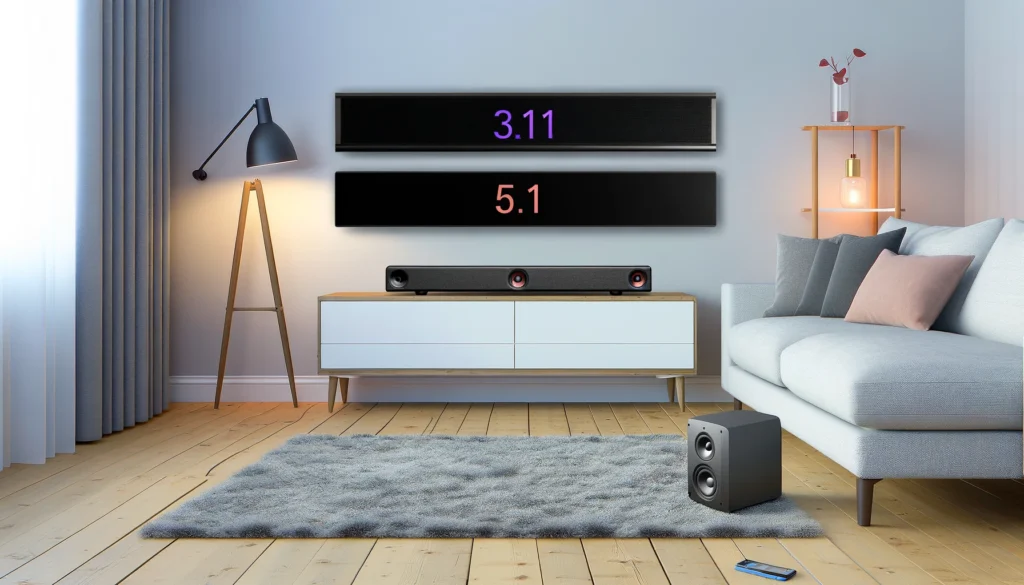
In short, dedicated 5.1 soundbars with distinct surround speakers and subwoofers unlock far more immersive, theater-quality audio than 3.1 models constrained to stereo output.
However, 3.1 systems provide audio elevations over TV speakers more affordably.
Determining ideal room sizes, content support needs, expandability preferences and pricing thresholds helps establish perfect personal matches. We’ll analyze key soundbar differences in more detail below.
What Do The Numbers Mean?
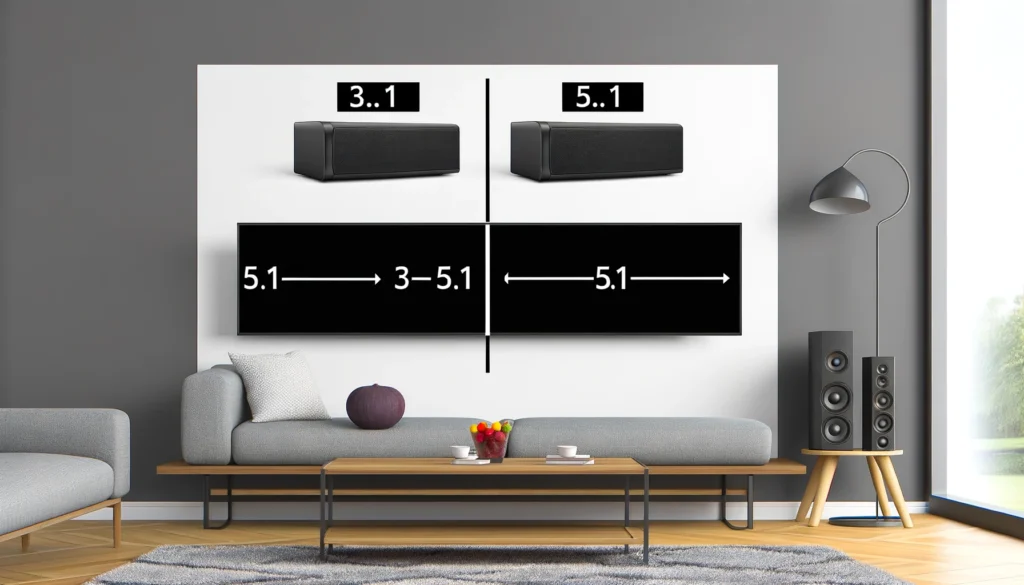
When reviewing and comparing soundbar specifications, you’ll notice certain systems described as 3.1 channel or 5.1 channel configurations. But what do these numerical designations actually mean?
Essentially, the first number refers to the quantity of unique audio channels the soundbar supports, either with its own integrated speakers or supplementary satellite speakers and subwoofers.
The .1 represents whether a dedicated low-frequency effects subwoofer is included.
So a 5.1 channel soundbar system comprises five distinct channels including right front, left front, center, right surround, and left surround speakers.
The “.1” denotes the additional low-frequency sub. This is the standard speaker configuration used for Dolby Digital and DTS surround sound.
Comparatively, 3.1 channel soundbars only incorporate left, right, and center front speakers for a wider but less surrounding front soundstage, lacking actual rear channels. The subwoofer handles deep bass just like 5.1 setups.
In summary, more channels or speakers allows audio output to become better dispersed for a fuller, more enveloping bubble of sound compared to soundbars without dedicated side or surround drivers.
Key Sound Quality Differences
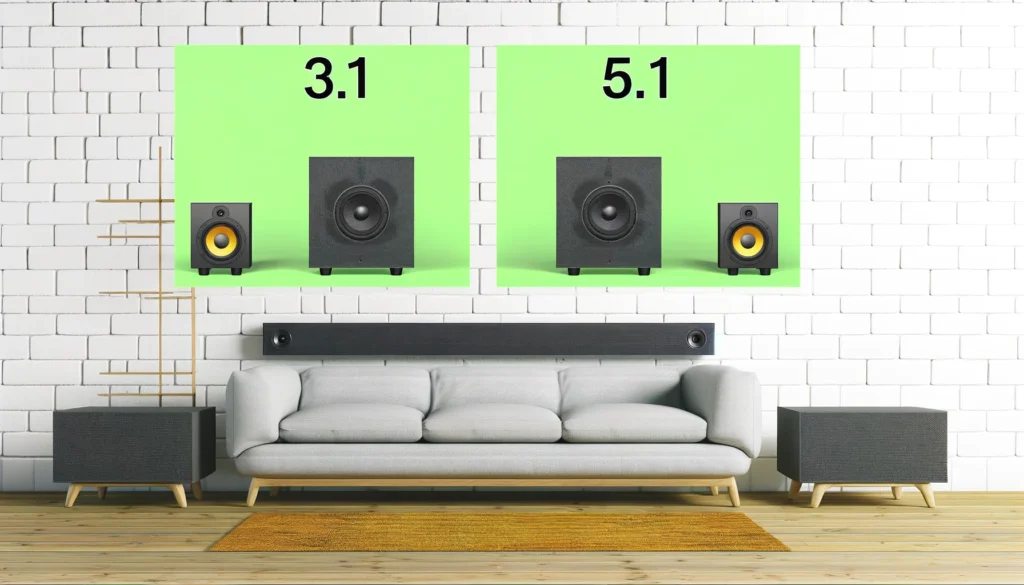
Beyond just more speakers, why does the number of channels directly impact sound quality and listening experiences?
First and foremost, true dedicated center channels allow for clearer vocal reproduction and enhanced dialogue intelligibility. Since most movie and television dialogue gets channeled to center speakers, having Crisp, non-muffled voice pickup is crucial.
Likewise, discrete side-firing driver arrays as found in 5.1 soundbar systems create immersive wall-of-sound effects as audio pans seamlessly from the front to surround positions. Sounds travel around listeners rather than just left to right stereoscopically.
With Dolby and DTS multi-channel surround sound processing, individual tracks get fed to different speaker channels very precisely.
5.1 soundbars properly honor this channel separation for greater precision fidelity and imaging accuracy louder, clearer world-building.
In contrast, 3.1 soundbars by design can only reproduce two-channel left/right stereo audio. All sound effects and music collapse into a wider but flatter frontal presentation.
Without those rear speaker channels, surround mixes lose intended positioning.
Ideal Room Sizes
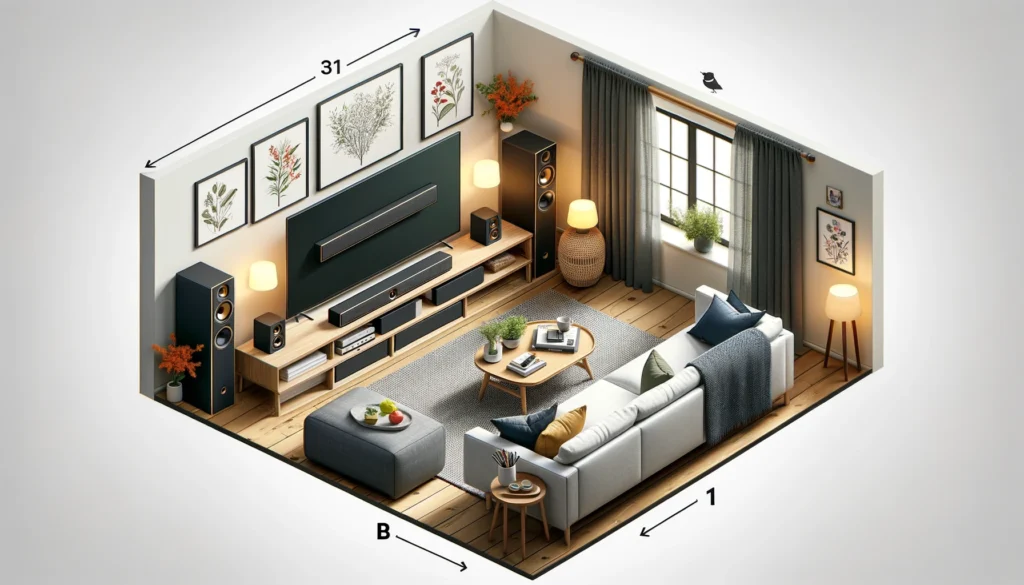
Given their wider horizontal dispersion of audio, 5.1 channel soundbars inherently work best in medium to large rooms where more dispersed speaker layouts can bathe listeners effectively from all angles.
The wider front stage creates clearly separated left, center and right channels distinguishing dialogue against sound effects and score crescendos. Surrounds capably reverberate ambient noises around walls with purposeful echo.
However cramming 5.1 soundbars into smaller tight spaces would overwhelm listeners negating benefits.
Comparatively, the focused left, center and right speaker configuration of 3.1 channel soundbars makes them perfect for desktops, dorms, kitchens, offices and bedrooms where blasting surround audio might disrupt housemates or neighbors.
Their frontal sound focus containing audio rather than surrounding still elevates basic TV speakers.
Owners lacking space behind seating arrangements find 3.1 soundbars simpler from a cabling and installation perspective too.
Many 3.1 models boast unified frames housing all drivers, rather than relying on satellites and subwoofers. Reduced hardware congestion keeps impacts minimal in tighter quarters while retaining sound quality jumps.
Content Support Variances
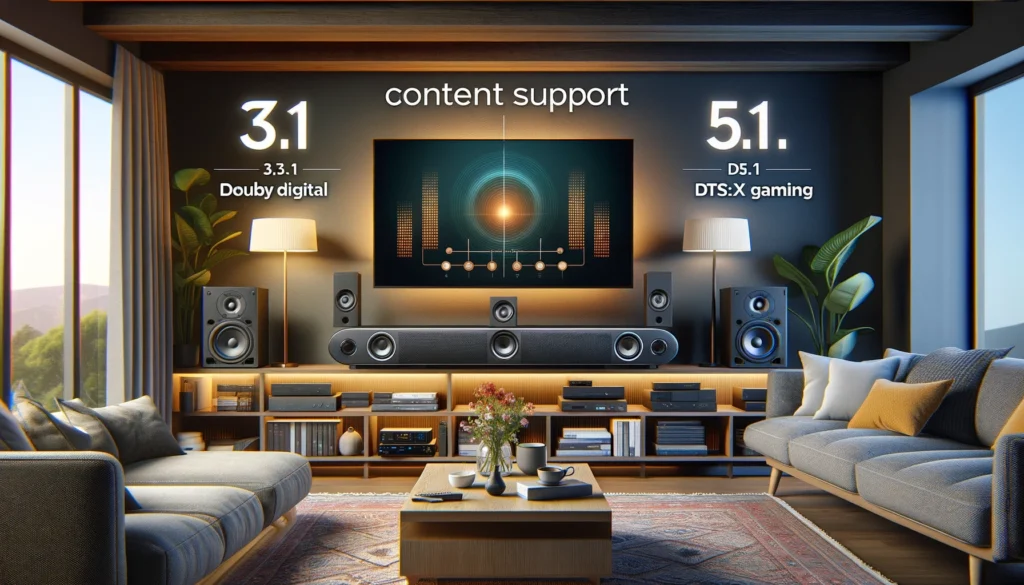
Beyond pure audio presentation quality differences, 5.1 and 3.1 channel soundbars also vary significantly regarding the breadth of content and media formats they can successfully handle from properly processing respective multichannel audio tracks.
Premium 5.1 channel soundbars tend to incorporate full Dolby Digital, DTS Digital Surround and Dolby Atmos / DTS:X 3D surround decodingsupport for accurately playing back Blu-rays, digital streaming feeds and modern gaming audio.
Having discrete arrays of five or more speakers plus a sub directly maps to channel-based audio formats for crisp directional effects. By design 5.1 setups cater towards these digital multichannel surround mixes.
In contrast, entry-level 3.1 soundbars lack adequate channel or driver counts to resolve more than basic 2-channel stereo PCM signals.
While they may boast pseudo-surround DSP effects to simulate wider soundstages, native output remains limited to two-channel left/right audio only.
This means 3.1 soundbars cannot properly unpack complex 5.1 or 7.1 Blu-ray soundtracks. Streamed content or gaming audio reliant on multichannel mixes will downsample channels losing intended positioning mixing elements strangely.
Sticking to stereo media is ideal.
Connectivity & Placement Factors
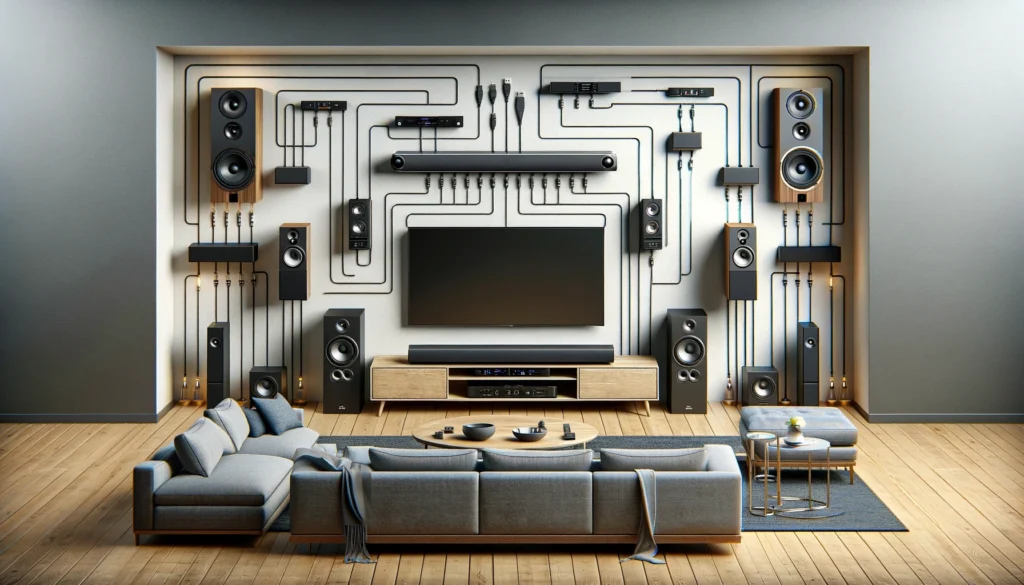
5.1 and 3.1 soundbars also differ regarding physical connectivity options which impacts setup flexibility. As 5.1 configurations demand more channels fed through distinct speaker arrays, this translates to extra wired hookup considerations.
Most 5.1 soundbars require two or three HDMI inputs to accommodate modern devices, HDMI output to the television, and multiple audio line inputs to feed satellite speaker channels.
Even wireless rear speaker kits need separate power sources. Compared to simpler all-in-one designs, setup complexity increases.
Expanded input/output options provide more ways to integrate the soundbar as the central entertainment hub though.
With multiple HDMI ports, you can connect varied 4K HDR media streamers and disc players simultaneously leveraging a shared excellent speaker system.
In contrast, unified 3.1 soundbar frames with built-in left/right channels demand fewer cables. Self-contained drivers inside the soundbar chassis don’t require satellite speaker positioning or external subwoofers taking up floor space.
3.1 bars offer greater placement flexibility on shelves or mounted on walls.
Pricing Differences to Expect

Given their more advanced internal components, external satellite speaker support, and decoding capabilities beyond basic 2-channel PCM audio.
5.1 channel soundbars that deliver meaningful surround sound enhancement cost more than mass-market 3.1 channel systems.
Major brands sell entry-level 3.1 soundbars packing decent sonic punch over TV speakers for budget buyers, retailing between $100 to $500.
Large left and right driver arrays plus integrated subwoofers propel major audio elevations without financing headaches.
There are exceptions where brands leverage virtualization techniques to simulate surround effects from cheaper 3.1 hardware configs.
But native, discrete 5.1 output requires physical surround speaker channels that entry-level buyers may not require.
In the midrange sphere from $500 to $1,000 reside 5.1 soundbars achieving that crucial balance of serious but not over-the-top cinematic audio immersion fueled by genuine surround speaker decoding.
This is the audio sweet spot blending price and performance for many households.
True surround sound devotion demands 5.1 setups. But more budget-friendly 3.1 options still outgun TV speakers, especially in secondary rooms.
Choose designs suiting your exacting needs and pricing pain points wisely!
Conclusion
In summary, 5.1 channel soundbars that incorporate discrete surround speakers demonstrably unlock more immersive cinematic audio than 3.1 models limited to basic stereo presentation.
However, compact 3.1 systems still outperform TV speakers and suit smaller rooms well. Evaluate your space, budget, and audio format priorities before deciding.
